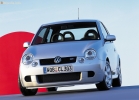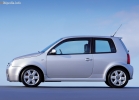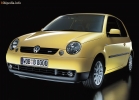Test drive Volkswagen Lupo GTI 2002 - 2005 hatchback
Three liters are not the limit
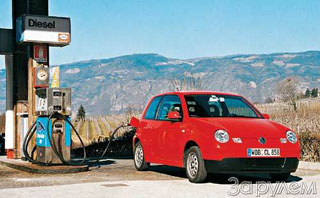 In the third country, for the second thousand kilometers
In the third country, for the second thousand kilometers The first fuel tank came to an end ...
Oil on the planet is less and less, fuel is more and more expensive, environmental requirements are harder. However, in the near future, a massive transition to alternative types of fuel seems to us does not threaten us: traditional ICEs continue to surprise with more modest expenses. The record holder among serial models is a three -liter diesel Volkswagen -Lupo 3L TDI (ZR, 1999, No. 5): only 2.99 l diesel fuel per 100 km (on average, according to the European cycle 93/116 EG 2).
But how close is this ceremonial indicator to the real operational? Does the driver feel a flawed hostage of rigid economy? Did Lupo remain a full -fledged car? To answer these and other questions, the author drove 3,000 km on it in four days on the roads of five countries.
In the parking lot in front of the Berlin Airport, Schenefeld immediately grabbed a miniature bright red Volkswagen-Lupo. The device shows a full tank, but for the sake of the purity of the experiment, I pour another one and a half liters on the nearest column before cutting off the gun and dump the daily mileage counter to zero. Now the course is to the south, to unwind the loop of the ring route: almost half a European Europe.
I occupy the right row on the autobahn and begin experiments with various traffic modes. Speed \u200b\u200b80 km/h, the arrow of the indicator of instant flow rate at first floats between 2.0 and 3.0 l/100 km. Soon he was adapted - the leg was petrified onto the gas pedal and the arrow glued to 2.5. The same value an hour later was shown by a route computer calculating the average consumption. I increase the speed to a hundred, reset the computer and drive the second site for another hour - the result is 3.0. Now in the middle row - hundreds who occupy the right lane do not go faster. At 120 km/h, fuel consumption was already 3.6 liters, and at 140 - 4.3 l/100 km. I accelerated to 160 km/h - this super -economic baby is capable of this! - But here you have to overtake, rebuild ... In general, it is not possible to go on even gas, so the total 5.4 l/100 km is very approximate. However, how do you like such indicators?!
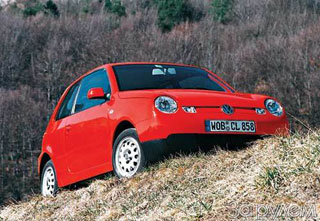 They just fascinated me. So much so that I forgot about lunch and came to my senses only in the evening, dismissing 700 km around Germany and seeing the flag of the European Union and Austria's sign. By the way, the fuel pointer in the tank (with a volume of only 34 liters!) Barely passed half a level ...
They just fascinated me. So much so that I forgot about lunch and came to my senses only in the evening, dismissing 700 km around Germany and seeing the flag of the European Union and Austria's sign. By the way, the fuel pointer in the tank (with a volume of only 34 liters!) Barely passed half a level ... Having hastily snacking in a roadside cafe, I drive into the alpine foothills. I must say, the rise (very insignificant, some kind of share of a percent) began for a long time. In other conditions, I would not have noticed it, but not now - the flowmeter hand immediately threw 0.3 liters immediately. It started to rain - lay out an additional 0.2 liters per hundred. After all, the aerodynamic resistance is proportional to the density of the air, and the drops hanging in it, figuratively speaking, increase it. Approximately the same headlights eat, about 0.1 liters - a radio receiver. Probably, it is precisely the desire to meet the magic 3 l/100 km that the absence of the steering wheel amplifier is explained - after all, it also needs to be fed. True, I have never complained about this, even when parking. Air conditioning is also only in the list of additional equipment.
And the mountains are higher, and the mountains are more cooler, and the mountains go under the very clouds! Following them, to the very edge of the scale, where there is a giant number 5.0, from time to time the flow meter rises. Fu-uh, finally, a pass! Now down to sunny Italy. At the eleventh o'clock in the morning, I rolled into Bolsano (Italians for some reason call him Bozen). Well, two thousand kilometers on an airplane and almost a thousand by car - there is more than enough for the pattern.
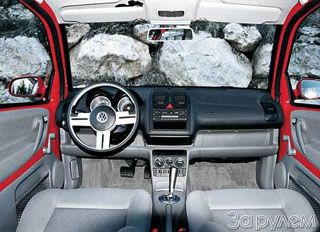 On the second day, the fuel reserve lamp caught fire; Pour 29.5 liters when indicating a daily run meter of 1004 km. Thus, the average consumption is 2.93 l/100 km. Then I move slowly, allegedly modeling a calm ride on local paths and all kinds of trees, but in fact I enjoy the sun, blooming trees, life and ... a machine.
On the second day, the fuel reserve lamp caught fire; Pour 29.5 liters when indicating a daily run meter of 1004 km. Thus, the average consumption is 2.93 l/100 km. Then I move slowly, allegedly modeling a calm ride on local paths and all kinds of trees, but in fact I enjoy the sun, blooming trees, life and ... a machine. Recalling the dimensions of the OKU, Lupo is much wider and does not constrain passengers at all. In any case, the front ones. The back, of course, is not so free, but still more spacious than you expect from a double sofa. A little trick helps - the backs of the front seats are unusually thin, very curved and completely not constrain the knees. The salon has a noticeable naked iron, but plastic, where it is, is soft and solid. The topic of lightness, and the modification of 3L TDI, mainly thanks to light alloys, lost 125 kg, can also be traced in the interior. First of all, this applies to the steering wheel - silver magnesium hubs, knitting needles and the inside of the rim make it visually very light.
While traveling around Northern Italy, I figured out an automatic gearbox. More precisely, this is a five -speed mechanics with automatic control. Like a machine gun, there is no clutch pedal. Switching occur very softly, without jerking, but quickly and almost imperceptibly. If you remove the leg from the accelerator, the neutral is automatically turned on, the engine is idling and the machine moves. (In such cases, it would be possible to drown out the engine for greater savings.) Slightly stomped along the brake pedal - the transmission turns on and the machine slows down with the engine with sequential switching down and zero fuel consumption. When stopping, the transmission is disconnected, and in the start mode mode, after a two-second delay, the engine also turns off. By the way, suddenly stalled at a traffic light, diesel often causes increased interest among drivers of neighboring cars. We loosened the pressure on the brake to a minimum - the motor comes to life again, the first gear is turned on, which is confirmed by a slight impetus. He transferred his leg to the accelerator - and Katya forward. The box also has a manual control of the tiptronics.
Among the temperamental Italian drivers, I did not feel completely deprived of power and dynamics. Even a slightly more sluggish touch from the place - if the start was missing and did not have time to put the diesel and turn on the transmission in advance - with more than compensated by a powerful acceleration that allows you to break away from the main stream. Still, 140 Newton-meters, and even at 1800 rpm, is enough for a machine weighing only 855 kg. Of course, the fuel consumption in the city is higher, but even in Milan traffic jams or on the narrow streets of ancient Florence, it has never exceeded 4.8 liters.
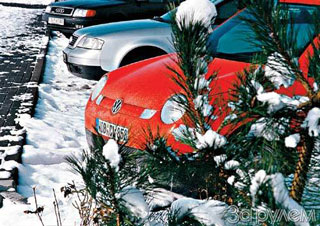 On the third day, slowly approaching Lyon at a speed of 80 km/h, I make a discovery right: Lupo is scared of large trucks! Turners from oncoming and passing trucks are either adjusted or inhibited by a baby whose driver is concerned with fuel economy. This is especially noticeable in the long eleven -kilometer, but narrow, in two stripes, the tunel of Monte Bianko, connecting Italy and France. Incidentally, optimizing the form of Lupo, in particular, the front bumper and the holes of the air intakes, gave the coefficient of the frontal resistance of SC \u003d 0.29 magnificent for such a kutz and unreasonable car.
On the third day, slowly approaching Lyon at a speed of 80 km/h, I make a discovery right: Lupo is scared of large trucks! Turners from oncoming and passing trucks are either adjusted or inhibited by a baby whose driver is concerned with fuel economy. This is especially noticeable in the long eleven -kilometer, but narrow, in two stripes, the tunel of Monte Bianko, connecting Italy and France. Incidentally, optimizing the form of Lupo, in particular, the front bumper and the holes of the air intakes, gave the coefficient of the frontal resistance of SC \u003d 0.29 magnificent for such a kutz and unreasonable car. At the entrance to Luxembourg, the time of the second refueling came. Starting again from scratch, now the counter has reached 1129 km, and although Lupo could freely drive a hundred, break himself and cross out the entire previous driver’s experience - and so more than a hundred kilometers rode on the light bulb. The tank placed 30.3 l - the average consumption of 2.68 l/100 km!
On the last day of the trip, wet snow fell - like this, from almost summer Mediterranean to winter Westphalia. I am tired of experimenting, swaying in economical mode, thinking about impressions. As a driver, I did not feel any restrictions. Perhaps in limit modes, a three -liter modification will behave differently than an ordinary Lupo - it is on it are Bridgostone -B381 Eco -Pisa tires with reduced rolling resistance and an internal pressure of 4.2 atm (!), But you practically do not notice the differences with a calm ride. If I was driving, how to swear, without looking at the pointer's arrow, - well, I would bring on average four per hundred liters. And this is with all high -speed highways, mountain passes and city traffic jams! And if you consider that diesel fuel is twenty percent cheaper than gasoline - saving on a fuel more than two -time.
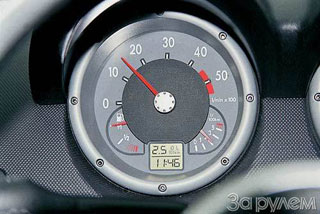 In the suburbs of Berlin, having passed 890 km, he stopped for the last refueling - 22.3 liters and, respectively, 2.51 l/100 km! I would have drove another five thousand - you look, I would have reached two liters ... jokes, but it's time to summarize: 82.1 liters of diesel fuel were spent on the total mileage of 3024 km. That is, every hundred kilometers took an average of only 2.71 liters !!! In general, refuel from the pay - and the month ride calmly ...
In the suburbs of Berlin, having passed 890 km, he stopped for the last refueling - 22.3 liters and, respectively, 2.51 l/100 km! I would have drove another five thousand - you look, I would have reached two liters ... jokes, but it's time to summarize: 82.1 liters of diesel fuel were spent on the total mileage of 3024 km. That is, every hundred kilometers took an average of only 2.71 liters !!! In general, refuel from the pay - and the month ride calmly ... One of the ways to reduce fuel consumption is the maximum relief of the car. Here, wings, hood, side doors, the outer panel of the rear door, and the backcases of the seats are made from the aluminum alloy. And besides, wheel discs, cylinder block and engine head, front brake calipers, shock absorbers, beam and front suspension levers. From the magnesium alloy - the inner panel of the rear door and the frame of the steering wheel. We also worked on steel details. For example, the beam of the rear bridge made of highly alloy steel turned out to be easier with the same strength. Even the shafts of the gearbox are hollow. Glass, tires are facilitated, but what is there in the upholstery of the seats a lightweight (!) Foam. All these measures made it possible to reduce the mass of the car by 125 kg compared with the base of Lupo.
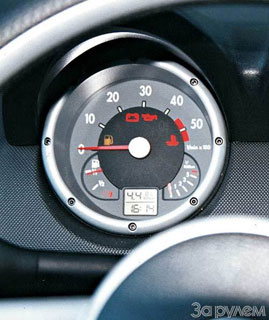 The super-economy three-cylinder diesel diesel 1.2 liter is equipped with a fuel-phase-fuel pump, developing pressure up to 2050 bar, a boost of a garrett with an adjustable turbine and a maximum boost pressure of 1 bar, an intermediate cooler and satisfies the strictest D4 toxicity standards, which will become obligatory only with 2005 (Read more in ZR, 1999, No. 1).
The super-economy three-cylinder diesel diesel 1.2 liter is equipped with a fuel-phase-fuel pump, developing pressure up to 2050 bar, a boost of a garrett with an adjustable turbine and a maximum boost pressure of 1 bar, an intermediate cooler and satisfies the strictest D4 toxicity standards, which will become obligatory only with 2005 (Read more in ZR, 1999, No. 1). The automatic gear selector is the same as that of the usual hydromechanical: Stop - an analogue of Parking, R - reverse, n - neutral, e - analogue Drive. In the left position of the lever, the semiautomatic control mode Tiptronic: the interpretation of the lever forward, the box switches one gear up, back - one down.
Volkswagen Lupo 3L TDI
General data: number of places - 4; Equipped mass - 855 kg; full weight - 1210 kg; maximum speed - 165 km/h; acceleration time from a place to 100 km/h - 14.5 s; fuel consumption in conditional suburban and city cycles - 2.7; 3.6 l/100 km; fuel supply - 34 liters; Fuel is diesel. Dimensions, mm: length - 3529; width - 1621; height - 1464; base - 2319; The track in front/back - 1425/1400; Road clearance - 110; The volume of the trunk is 130 (140 - with the vertical position of the back)/830 l; The turning radius is 5.2 m. The engine: diesel, three -cylinder, in order, with turbocharged and intercooler, is located in front of the front; working volume - 1191 cm; cylinder diameter and piston stroke - 76.5x86.4 mm; compression degree - 19.5; Power - 45 kW/61 l. With. at 4000 rpm; The maximum torque is 140 N.M at 1800-2000 rpm. Transmission: front wheel drive; gearbox - an automatic five -speed (without hydrotransformer) with the possibility of manual control; Transporting numbers: I - 3.45; II - 1.96; III - 1.18; IV - 1.03; V - 0.81; h. X. - 3.36; The main program is 3.33. Suspension: in front - like McEferson, behind - longitudinal levers connected by an elastic transverse beam. Brakes: hydraulic with a vacuum amplifier and ABS, in front - ventilated disk, back - drum. Steering: rheck. Tire size: 155/65R14.
Text, photo / Yuri Nechetov
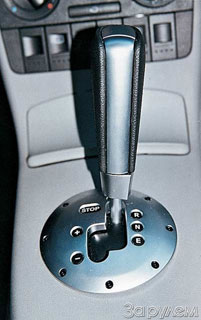
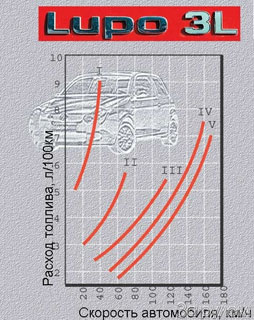
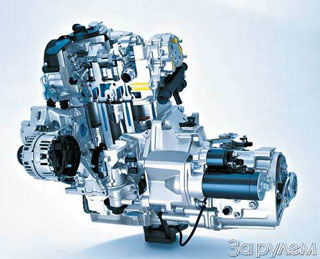
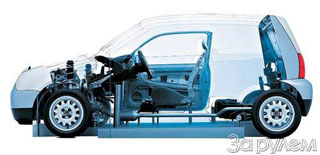
Source: The magazine "Driving"



